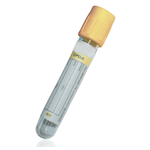Suitable Specimen Types
- Serum
- Li Hep
Sample Processing in Laboratory
UsualSample Preparation
CentrifugeTurnaround Time
1 daySample Stability
4 ºCTransferrin
General Information
Indications: Assessment of iron-deficiency anaemia
Transferrin and transferrin saturation levels (reported as percent iron binding) are available as part of the iron set
Iron binding capacity measurements are used in the diagnosis and treatment of anaemias. Serum iron is carried by binding to the transport protein, Transferrin. The measurement of the maximum concentration of iron that Transferrin can bind is called the Total Iron Binding Capacity (TIBC). Normally, only about one third of the iron binding sites of Transferrin are occupied by Fe (III); therefore, serum has considerable reserve iron binding capacity.
Total Iron Binding Capacity (TIBC) equals the Transferrin concentration x 22.6.
Percent Iron Binding Capacity (or transferrin saturation) equals the (iron concentration / TIBC) x 100.
Transferrin saturation and UIBC have equal reliability in ability to predict hemochromatosis. From 06.07.2020, transferrin measurement has replaced UIBC measurement in the iron profile.
Patient Preparation
None
Reference Range
Transferrin Reference ranges:
|
1 to 14 years |
Male |
1.86 - 3.88 |
|
Female |
1.80 - 3.91 |
|
|
> 14 to 60 years |
Male |
1.74 - 3.64 |
|
Female |
1.80 - 3.82 |
|
|
> 60 to 80 years |
Male |
1.63 - 3.44 |
|
Female |
1.73 - 3.60 |
Source of Reference Range
Abbott Alinity kit insertSpecifications
- EQA Scheme?: Yes
- EQA Status: NEQAS
